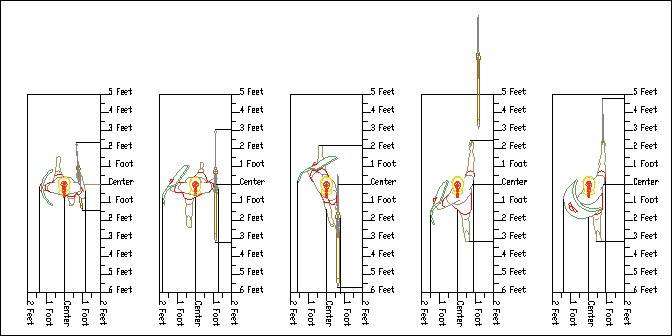The spacing of individual soldiers
There is an ongoing question of the spacing required by legionaries. Vegetius says that each soldier required 1.83m (6’) of space. Most texts describe the legionary formation with spacing between the files of 0.9m (3’) and between the ranks of either 0.9m (3’) or 1.22 (4’). Some authors acquire additional space by spreading the close order "muster" formation into an open order fighting formation. One author has alternate soldiers in the first rank step forward.
The analysis by various authors is confusing and sometimes contradictory. Connolly notes that Polybius says there were 2 men in the phalanx front rank opposite each Roman soldier; each Roman faced 10 pikes and since 5 ranks of pikes extended beyond the front this meant the single Roman file faced two files in the phalanx. If the phalanx files were on one meter (three foot) spacing then the Romans would have been on two meter (six foot) spacing. Judson, citing Rüstow, puts men on one meter (three foot) centers but at the command laxate manipulos has alternate men step forward. Delbrück and Parker place both rank and file on one meter (three foot) intervals but Delbrück staggers the ranks to allow 2 meters between men in the same file.
There are many interpretations of what the spacing was. It may be useful to ask, what is the minimum distance which would be required? The drawing below show the clearances needed for some of the typical actions of a legionary in various battle positions. The first figure to the far left is marching. A second marcher could be positioned 3 feet behind or in front. The second figure is running with his pilum held in a horizontal position preparatory to throwing it. A soldier three feet behind or in front this man would be in grave danger being impaled by the pilum. The third and fourth figures show the soldier throwing the pilum, first extending his arm behind him to throw his pilum, then releasing it. The minimum safe clearance here is about 6 feet either front or back. The last figure shows a typical fighting position in which the soldier is thrusting forward with his sword. The lateral clearance required is only about 18" so that soldiers could be placed at 3’ intervals.
The first figure to the far left is marching. A second marcher could be positioned 3 feet behind or in front. The second figure is running with his pilum held in a horizontal position preparatory to throwing it. A soldier three feet behind or in front this man would be in grave danger being impaled by the pilum. The third and fourth figures show the soldier throwing the pilum, first extending his arm behind him to throw his pilum, then releasing it. The minimum safe clearance here is about 6 feet either front or back. The last figure shows a typical fighting position in which the soldier is thrusting forward with his sword. The lateral clearance required is only about 18" so that soldiers could be placed at 3’ intervals.
 Three foot spacing for the files would give each man 0.48m (18") on either side of center. This spacing could be a problem when running with the pilum and throwing it, especially if the soldiers were expected to hold ranks over uneven ground. For charging with swords and for hand-to-hand fighting three feet would be more adequate. The illustration at the left illustrates the Roman style of sword fighting. They taught their soldiers to thrust with the point of the sword, not slash with the blade. This style of fighting would not require excessive lateral space between soldiers.
Three foot spacing for the files would give each man 0.48m (18") on either side of center. This spacing could be a problem when running with the pilum and throwing it, especially if the soldiers were expected to hold ranks over uneven ground. For charging with swords and for hand-to-hand fighting three feet would be more adequate. The illustration at the left illustrates the Roman style of sword fighting. They taught their soldiers to thrust with the point of the sword, not slash with the blade. This style of fighting would not require excessive lateral space between soldiers.
In their demonstrations, re-enactors are able to effectively charge in a tight formation with swords drawn, running virtually shield to shield. This demonstrates that at least that portion of the attack could be done in very tight quarters. They also report that the action of throwing the pilum does not require much lateral space. The Society for Creative Anachronism holds full contact battles with wooden weapons. They have little to teach about the Roman legion but one participant who is a "Roman" soldier did have one useful comment. He noted that even in their mock battles it is very important psychologically to know who is next to you and behind you. The support and protection of those around you is critical to one’s ability to fight. If this is true in a mock battle, it must have been more so in real ones. This would seem to argue in favor of a closer spacing. Given the considerations above, a lateral spacing of three feet seems appropriate.
In the sections which follow the models of the legion were designed on 3’ spacing for the files and with the required minimum clearances between the ranks for each activity.

